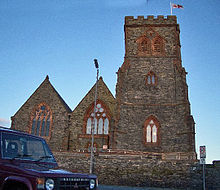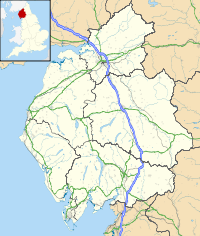- St. George's Church, Barrow-in-Furness
-
St. George's Church 
St. George's Church, viewed from the westLocation in Cumbria Coordinates: 54°06′30″N 3°13′15″W / 54.1084°N 3.2209°W OS grid reference SD 203 688 Location Barrow-in-Furness, Cumbria Country England Denomination Anglican Website St. George,
Barrow-in-FurnessHistory Founder(s) Duke of Buccleuch,
Duke of DevonshireDedication Saint George Significant associated people Sir James Ramsden Architecture Status Parish church Functional status Active Heritage designation Grade II Designated 6 May 1976 Architect(s) E. G. Paley,
Paley and AustinArchitectural type Church Style Gothic Revival Groundbreaking 1859 Completed 1883 Specifications Materials Slate with sandstone dressings
Slate roofsAdministration Parish St. George with St Luke Barrow-in-Furness Deanery Barrow Archdeaconry Westmoreland and Furness Diocese Carlisle Province York Clergy Vicar(s) Revd Ian Malcolm Harvey St. George's Church is in Central ward of Barrow-in-Furness, Cumbria, England. It is the oldest active Anglican parish church in the deanery of Barrow in the archdeaconry of Westmoreland and Furness (the Diocese of Carlisle). Its benefice is united with those of St Aidan, Newbarns, St Luke, Risedale, and St Perran, Roose.[1] The church has been designated by English Heritage as a Grade II listed building.[2] It stands at the southeast extremity of the town.[3]
Contents
History
The church was built between 1859 and 1861, to a design by the Lancaster architect E. G. Paley. Its patrons were the Duke of Buccleuch and the Duke of Devonshire.[2] It was built at the suggestion of Sir James Ramsden to be the parish church in the developing town of Barrow-in-Furness. However it was left in a peripheral position as the town grew away from it, and especially when the railway station was relocated in 1882. The north aisle was added in 1867. In 1883 the Ramsden Chapel was added, and the chancel was increased in size, being made higher and longer.[4] This work was carried out by the partnership of Paley and Austin.[5] The stained glass in the east window was destroyed in the Second World War. In 1982 the north aisle was partitioned off, and most of its furnishings were removed.[4] Since the partitioning, the north aisle has been used as a church hall.[2]
Architecture
Exterior
St. George's is constructed in dry-jointed slate with red sandstone dressings; the roofs are slated. Its plan consists of a five-bay nave with north and south aisles under separate roofs, south and west porches, a two-bay chancel with a chapel to the south, an organ chamber and a vestry to the north, and a tower at the west end of the south aisle. The tower is in three stages with diagonal buttresses, and an octagonal stair turret at its southeast corner. The parapet is embattled. The windows contain Geometric tracery.[2]
Interior
The arcades are carried on alternate octagonal and circular piers, their capitals being carved with foliage.[2] The stained glass in the east window dates from 1951 and was designed by A. F. Erridge of Whipple and Company. Also in the church is stained glass by Hardman, and by Shrigley and Hunt.[4] The three-manual organ was built in 1881 by Young.[6]
See also
- List of ecclesiastical works by E. G. Paley
- List of ecclesiastical works by Paley and Austin
- List of places of worship in Barrow-in-Furness
- Listed buildings in Barrow-in-Furness
References
- ^ St. George, Barrow-in-Furness, Church of England, http://www.achurchnearyou.com/barrow-in-furness-st-george/, retrieved 1 June 2011
- ^ a b c d e "Church of St. George, Barrow-in-Furness", The National Heritage List for England (English Heritage), 2011, http://list.english-heritage.org.uk/resultsingle.aspx?uid=1201077, retrieved 1 June 2011
- ^ Barrow-in-Furness, Streetmap, http://streetmap.co.uk/grid/320188_468766_106, retrieved 1 June 2011
- ^ a b c Hyde, Matthew; Pevsner, Nikolaus (2010) [1967], Cumbria, The Buildings of England, New Haven and London: Yale University Press, pp. 131–132, ISBN 978-0-300-12663-1
- ^ Price, James (1998), Sharpe, Paley and Austin: A Lancaster Architectural Practice 1836–1942, Lancaster: Centre for North-West Regional Studies, p. 79, ISBN 1-86220-054-8
- ^ Lancashire (Cumbria), Barrow in Furness, St. George the Martyr (N10770), British Institute of Organ Studies, http://www.npor.org.uk/cgi-bin/Rsearch.cgi?Fn=Rsearch&rec_index=N10770, retrieved 1 June 2011
Categories:- Churches in Barrow-in-Furness
- Church of England churches in Cumbria
- Diocese of Carlisle
- Grade II listed churches
- Grade II listed buildings in Cumbria
- Gothic Revival architecture in Cumbria
- Religious buildings completed in 1861
- 19th-century Anglican church buildings
- Buildings and structures completed in 1883
- E. G. Paley buildings
- Paley and Austin buildings
Wikimedia Foundation. 2010.

